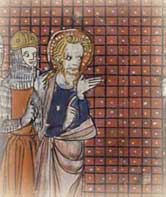I have to think he would be appalled that he is remembered on this day in this way...

Today we exchange cards expressing love or appreciation for one another. According to tradition, on this day, February 14, 269, a young man named Valentine was executed in Rome for his faith. But what does our exchange of sentimental cards have to do with a third century martyr?
Actually, the connection is not at all clear. Valentine was martyred the day before the pagan festival to the goddess Februata Juno at which boys drew girls' names for acts of sexual promiscuity. Were legends about the martyr's death modified to replace the heathen custom? No one knows for sure. In fact, there may have been two or even three martyrs named Valentine who died in different parts of the empire at about the same time. We know little or nothing about any of them.
Take the Roman Valentine as an example. A city gate on the Flaminian Way and a chapel near it were named for him. Several ancient Christian writers mention his name. There is no doubt he lived and was tortured before being beaten with clubs and beheaded. And yet we have no sure account of why.
Some say this Valentine was a young man with a tender heart who aided Christians who were undergoing martyrdom. He was not even a Christian at the time. Arrested for his activities, he converted to faith while in prison and would not renounce it. Knowing he was going to die, he wrote letters to his friends saying "Remember your Valentine."
Another legend says that the Roman Valentine was a priest who defied the Emperor Claudius's temporary order and secretly married couples so the husbands wouldn't have to go to war. Claudius desperately needed more soldiers and did not appreciate this interference.
A third legend says the Roman Valentine was a priest who refused to sacrifice to pagan gods. Imprisoned for this, he gave testimony in prison and through his prayers the jailer's daughter was healed. On the day of his execution he left her a note signed "Your Valentine."
During the Middle ages it was popularly believed birds paired in mid-February. This also reaffirmed the association of romantic love with Valentine's name. Whatever the truth behind the legends, St. Valentine's day has become a day we connect with romance and friendship.

Today we exchange cards expressing love or appreciation for one another. According to tradition, on this day, February 14, 269, a young man named Valentine was executed in Rome for his faith. But what does our exchange of sentimental cards have to do with a third century martyr?
Actually, the connection is not at all clear. Valentine was martyred the day before the pagan festival to the goddess Februata Juno at which boys drew girls' names for acts of sexual promiscuity. Were legends about the martyr's death modified to replace the heathen custom? No one knows for sure. In fact, there may have been two or even three martyrs named Valentine who died in different parts of the empire at about the same time. We know little or nothing about any of them.
Take the Roman Valentine as an example. A city gate on the Flaminian Way and a chapel near it were named for him. Several ancient Christian writers mention his name. There is no doubt he lived and was tortured before being beaten with clubs and beheaded. And yet we have no sure account of why.
Some say this Valentine was a young man with a tender heart who aided Christians who were undergoing martyrdom. He was not even a Christian at the time. Arrested for his activities, he converted to faith while in prison and would not renounce it. Knowing he was going to die, he wrote letters to his friends saying "Remember your Valentine."
Another legend says that the Roman Valentine was a priest who defied the Emperor Claudius's temporary order and secretly married couples so the husbands wouldn't have to go to war. Claudius desperately needed more soldiers and did not appreciate this interference.
A third legend says the Roman Valentine was a priest who refused to sacrifice to pagan gods. Imprisoned for this, he gave testimony in prison and through his prayers the jailer's daughter was healed. On the day of his execution he left her a note signed "Your Valentine."
During the Middle ages it was popularly believed birds paired in mid-February. This also reaffirmed the association of romantic love with Valentine's name. Whatever the truth behind the legends, St. Valentine's day has become a day we connect with romance and friendship.
Bibliography:
- "History of Valentine's Day, the." History Channel. (www.historychannel.com/exhibits/valentine/history.html).
- Hutchinson, Ruth and Adams, Ruth. Every Day's a Holiday. New York: Harper and Brothers, 1951.
- Thurston, Herbert."St. Valentine." The Catholic Encyclopedia. New York: Robert Appleton, 1914.
- "Valentine, Saint." Encyclopedia Americana. Chicago: Encyclopedia Americana, corp., 1956.
- "Valentine, Saint." Encyclopedia Britannica. Chicago: Encyclopedia Britannica, Inc., 1967.
- "Valentine, St." The Oxford Dictionary of the Christian Church. Edited by F. L. Cross and E. A. Livingstone. Oxford, 1997.
- Various internet articles.